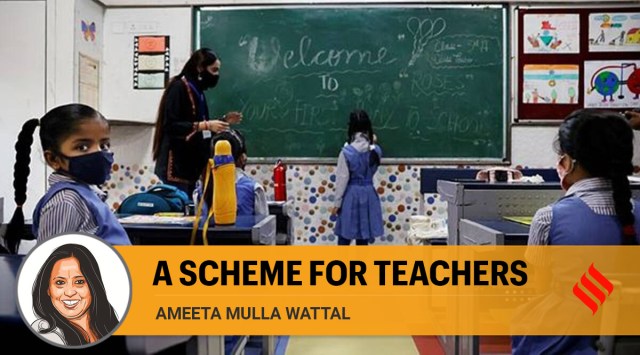- India
- International
The success of the novel PM SHRI schools scheme will depend on the quality of educators
Ameeta Mulla Wattal writes: Poor teaching is a product of systemic deficits that makes the teaching profession unattractive to a large number of talented people. A parallel teacher training programme must be in place to train the educators in the pedagogical practices proposed by the NEP.
 Ameeta Mulla Wattal writes: Four national curriculum frameworks have emphasised inquiry, creativity, discovery, problem-solving, decision making and joyful learning.
Ameeta Mulla Wattal writes: Four national curriculum frameworks have emphasised inquiry, creativity, discovery, problem-solving, decision making and joyful learning.The Union Cabinet’s approval of the PM SHRI schools scheme comes at a time when the schooling system is in disarray. Teachers seem to be caught in a time warp after the pandemic and the anxieties of children are increasing because of the switch to online classes during the public health emergency and then the pivot back to regular schooling. Confused school managements and parents are finding it difficult to address learning gaps. Where do we go from here? Perhaps towards a pedagogy based on activities, toys, art and projects and inclusive learning methods that incorporate sports and give vocational learning its due.
Four national curriculum frameworks have emphasised inquiry, creativity, discovery, problem-solving, decision making and joyful learning. How do the NEP 2020 and the new NCF that is likely to come into play soon differ from the earlier initiatives? Essentially in the weightage they accord to the above elements of classroom learning. The 14,500 PM SHRI schools could become the agencies for the change envisaged by the new policies. But that will require commitment, hard work and progressive thinking. These schools will need to find ways to reverse learning losses and ensure life outcomes that have a positive bearing on the nation’s economy — especially in the ways the country uses its demographic dividend. We need to find new ways to understand not just what the children learn but also how they learn. In India, 250 million children are out of classrooms and several million are in school, but unable to learn.
Hopefully, the PM SHRI schools will attract large investments from the Centre as well as state governments, apart from the separate budget allocated to them to upgrade their facilities. These schools promise to encompass all aspects of the NEP. Every region will have PM SHRI schools that will handhold and mentor other schools in their vicinity. A wide range of learning experiences, good physical infrastructure and appropriate resources will be available to students. A variety of pedagogies and assessment systems will be used along with the introduction of vocational education. Linkages with skill counsellors and local industry will be established to provide employment opportunities to students graduating from these institutions. The schools will be energy-efficient with natural farming patches, they will be equipped with rainwater harvesting systems and will enable the study of traditional environment-friendly practices. The community and alumni will be involved in activities such as career guidance and mentoring. Parents too will be trained to become home mentors. The school will become community centres after the regular hours and converge with existing schemes including PM Poshan, Samagrah Shiksha and Ayushman Bharat.
If these “ideal” schools accomplish even a quarter of their goals, they will make a significant difference to the educational landscape of the country. However, improving the quality of education is not just extremely challenging but also an expensive proposition, especially in countries that have large socio-economic gaps. Years of investment deficits in high-quality teachers, training and resource materials have led to cycles of poor learning. Breaking them will not be easy.
As a document, NEP 2020 is inspirational. However, it will remain on paper if teachers are not motivated to work hard. Currently, poor status, low salaries and inadequate working conditions deter talented people from entering the profession. However good these “rising schools” may be, they will not become meaningful centres of learning, if the teachers are not trained in the novel methodologies underlined in the NEP. We still do not have enough institutes with a curriculum that trains teachers for the schools of the future.
Poor teaching is a product of systemic deficits that makes the teaching profession unattractive to a large number of talented people. For the PM SHRI schools to succeed, a teacher training programme must be in place to train the educators in the pedagogical practices proposed by the NEP. As far as principals are concerned, there is a great crisis of leadership.

Perhaps, the government’s next initiative should be a “PM TRI” scheme — Teachers for Rising India.
The writer is Chairperson & Executive Director Education, Innovation and Training DLF Schools and Scholarship Programmes
EXPRESS OPINION
More Explained
Apr 26: Latest News
- 01
- 02
- 03
- 04
- 05











































